Fashion for the cultivation of majestic and graceful gladiolus did not bypassed the Gardeners of the Urals. Despite the fact that gladiolus came to us from hot tropics, experienced and enterprising gardeners learned to grow them in a colder climatic conditions. How to grow colorful gladiolus in the Urals? What you need to know gardeners on the storage of bulbs in winter? Is the technology of planting gladiolus in the Urals from the landing technology in the southern regions? Are there more resistant to weather conditions of gladiolus? We will tell about this and many other things in this article.
Gladiolus. Plant Description
Gladiolus is an unusually beautiful flower, which is also called a slot. This is explained by the form of his leaves. They are pointed, long and resemble swords. The word "Gladius" is translated from the Latin "sword". The flower's first mention has received another 300 years before our era. In ancient Greece, Gladiolus was originally an ornamental flower, which admired. He was a weed herb, which grew in the fields with wheat, and from him mercilessly got rid of. In ancient Rome, Gladiolus deserved a worthy place in the amazing gardens of rich Romans. Interesting facts about the gladiolus are the following:
- gladiolus - a perennial plant from the Iris family;
- the root system of gladiolus is represented in the form of a bulb;
- the stalk gladiolus is a reprehensive, reaches 50-150 cm in height;
- gladiolus leaves thin and long. They climb around the stem, giving it additional strength;
- the main charm of gladiolus are his flowers. They have a funnel shape, consist of 6 petals that are closed at the base with each other;
- colorful gladiolus flowers are collected in cooled inflorescences that can reach 80 cm long. Depending on the Gladiolus variety, these inflorescences can be located on the stem in different ways. Some of them are on the one hand stem, others - on both sides. There are also varieties of gladiolus, who have inflorescences of the spiral stem;
- the fruit of gladiolus is a box that is filled with small seeds;
- the bulb gladiolus is updated every year. May be different colors: from white to cherry;
- gladiolus flowers are affected by a variety of coloring. You can grow white, purple, red, blue and other gladioli;
- gladiolus is known not only as a decorative flower. In the ancient Greece, the gladiolus bulbs were kept for eating. In the middle ages of the bulbs were grinding to obtain flour, from which bread was baked;
- the first hybrid varieties of gladiolus were bred in 1837. At the moment, about 8,000 varieties are known;
- a huge number of hybrid gladiolus varieties was derived in Holland and England.
There is an incredibly beautiful legend about the appearance of gladiolus. After the victory of the Romans in the war with Thracians, many warriors were in slavery. They were decided to make gladiators to arrange spectacles for the public. One of these gladiators was two friends of Sevton and Teres. They were ordered to fight to death to earn a return to their homeland. Gladiators stuck their swords into the ground and refused to fight, for which were brutally killed. Swords after the death of friends turned into graceful flowers, which were later named gladiolus. In legends of different countries, you can meet other stories about the appearance of this flower. Gladiolus people personify the power of friendship, loyalty, loyalty and chivalry.
Gladiolus. Varieties
Hybrid varieties of gladiolus are the most popular for cultivation. As a rule, they are more resistant to unfavorable environmental conditions, more decorative. At the moment, more than 8,000 varieties of gladiolus are known. Of course, you do not need to know the features of all these varieties. But it will not be an excess skill to understand the classification of gladiols. If you buy landing material in the store, then you can notice a special code on the label. This code is an encrypted description of the variety. This type of gladiolus varieties was adopted in the mid-20th century by the North American Council of Gladiolusovodov. In this classification, which is used to the present, all gladioluses are divided into 5 huge groups:
- the size of the flower. Flowers in gladiolus can be miniature, small-color, firmware, large-flowered and gigantic. The smallest flowers may have a diameter less than 6 cm, and large - more than 14 cm;
- over the color of the flower. Gladiolus have one of the richest color palettes among all ornamental plants. They can be white, cream, yellow, green, orange, salmon, red, raspberry, pink, lilac, blue, smoky, brown. Each of these paints has several tones, each of which corresponds to a certain digital designation;
- in blossom timing. Gladiolus are conditionally divided into 7 groups of color dissolving: very early, early, mid-early, medium-late, late, very late;
- in the form of petals. Gladiolus are conventionally divided into 5 groups according to the degree of corrugation of petals: non-corrugated, moderately corrugated, corrugated, strong corrugated, very strong corrugated;
- in size of the bulbs. The bulb may be in diameter as less than 1 cm and more than 3 cm.
Early Gladioles for Urals
The climatic conditions of the Urals are characterized by sharp temperature differences during the day, uneven precipitation. Selects the varieties of gladioles for landing need very carefully. They must be maximum resistant to similar climatic conditions. Among these varieties can be listed:
- Ben Venuo. Excellent gladiolus grade, which blooms from the middle of the summer to the end. Gardeners love to grow "Ben Venuto" not only for decorating and landscaping the site, but also for cutting. Beautiful gentle pink shade flowers are collected in big inflorescences. Inflorescences can reach the length of 40 cm, and the plant itself is up to 130 cm;
- "Oasis". Flowers of this type of gladiolus have a pleasant and refreshing color - the color of Lyme. A bouquet of such gladiolus will look bright and unusual. Leaves are thin and swords. The plant reaches 140 cm in height. The plus of this variety of gladiolus is a rather large size of flowers;
- "Sonata". The plant is not too high. Reaches in height usually 100 cm. Purple flowers with white splashes inside are high decorative value. Grown and both for cutting in a bouquet and in decorative purposes;
- "Vista". This variety of gladiolus is often compared in coloring with pansies. Gladiolus are capable of reaching a height of 130 cm. Leaves of a pleasant green shade, thin, sword-shaped. The combination of several colors in the color of the gardeners, which prefer a bright and fiber appearance of decorative plants in their plot;
- "Ocill". One of the most graceful and sophisticated gladiolous varieties, which is suitable for growing in the Urals. Flowers seem incredibly air and lightweight thanks to the snow-white color. A minor disadvantage of this variety is not too "strong" stem, which is not always able to withstand the weight of the inflorescence. But this is easily corrected by the support, to which weaving the plant;
- "Azurro". It is this variety to create solemn bouquets. His saturated bloody red color immediately attracts attention. The plant reaches a height of 100 cm. Leaves are thin and sword-shaped;
- "Passus". If you burn the desire to grow bright and large-flowered gladioli, you can completely stop your choice on this class. The flower combines and delicate lilac, and juicy purple shades. Petals corrugated, which gives the plant even greater extravagance.;
- "Cook". Excellent early grade for growing in the Urals. Flowering phase comes in the second half of July. Flowers have tender salmon.
- "Gagarin's smile." Beautiful and large inflorescences from pink flowers with a red middle will be a real decoration of the Ural Garden. The plant is resistant to unfavorable environmental conditions.
Possible problems when growing gladioles in the Urals
You must clearly understand that gladiolus is a tropical plant that loves sunlight and warmth. The climate feature of the Urals is a rather short summer and a rapid autumn offensive. Beginner gardeners may be puzzled by the question of how it is still to correctly grow the gladiolus in the Urals. They may assume the following errors at the first attempt to grow gladiolus in the open soil in the Urals:
- too late landing. Many gardeners mistakenly believe that it is necessary to wait for the highest possible warming, warming the soil to plant the gladiolus. But with such a late landing of a chance, a timely launched in a vegetative period in a plant is very small. It will be on such abundant, the bulbs will be small;
- plant damage to frosts at the end of the growing season. With this problem there are almost every gardener in the Urals, which grows gladiolus. But, if you chose the variety correctly, such frosts should not cause significant harm to the plant. Ural hybrid gladiolus varieties have high resistance to similar temperature differences.
It means that the most correct strategy of growing gladiolus in the Urals will be an early planting, which will allow the plant in normal terms to start and complete its growing season.
Landing gladiols in the Urals in spring
When to get gladiolus to germinate in the Urals
For gladiols, preparing for landing in the Urals is the necessary event that should not be neglected. The bulbs prepared in this way give the most early and beautiful bloom. So, when is it worth "wake up" bulbs from hibernation and starting them to prepare them for the new season? The most optimal is the term of 2 weeks. 2 weeks before the expected landing, get your gladioles from the storage location. Take into account the following recommendations for germination of gladiols:
- the very first of your action with the bulbs after you got them out of the storage place, is their careful inspection. Perhaps the storage conditions were not entirely correct, and damage could arise in the bulbs, firing places, etc. Sort completely healthy bulbs from damaged;
- now it is time to clean the bulbs of gladioles from the husk. It is necessary to do it as carefully and carefully;
- lubricate a greener scratching, small damage on the bulbs;
- in order to prevent diseases, the method of soaking bulbs in a weak solution of manganese is widely used. Pour warm water into the container, add several crystals of manganese, so that the water is painted in a weak pink color, place the bulbs there for 1.5-2 hours. There can also be mashed onion and in another solution - a solution of copper sulfate (5 grams per 1 liter of warm water);
- spread the planting material of gladiolus into clean and dry tanks that need to be put in a dry place with scattered light. If you have many varieties of gladiolus, then write signs with the names of these varieties, so as not to confuse the bulbs.
Here is this method and the preparation of the gladiolus bulbs to the early spring landing is carried out. Immediately before planning into the ground, the seating material should be placed in a solid ash for 4-5 hours.
When to plant gladiolus in the Urals
The beginner gardeners of the Urals always concerns the question of when it is still worth landing gladioli into an open ground. There is no unambiguous answer to this question. It all depends on the specific climatic conditions at one time or another. Usually the landing time of gladiolus in the Urals falls on the second half of May. This is the perfect time when the earth is already warmed by the spring sunny rays, and the likelihood of strong frosts has already passed. Shift landing time by June is already undesirable. The climatic conditions of the Urals are such that the summer period is very short. Gladiolus, which were planted late, may not bloom at all. The ideal temperature of the soil for planting gladiolus is 15-17 degrees of heat, and the air temperature is not lower than 18 degrees of heat.
Choose a place to plant gladiols in the Urals
Special differences in choosing a place to land the gladiolus in the Urals and in more southern regions is not observed. Adhere to the minimum requirements of this plant to growth conditions:
- gladiolus - tropical plant. He loves well-lit places;
- avoid landing gladiolus in a complete shadow. The plant will not please you with the brightness of paints and lush flowering;
- if there are always drafts on your site, then select the most secure place. Exotic gladiolus does not like strong winds;
- do not choose a place for landing with groundwater adjacent to the surface. Gladiolus - a bulbous plant that reacts very negatively to the accumulation of fluid from the roots;
- the soil for planting gladiolus should be rich in humus and with an admixture of sand;
- it is not recommended to disembark gladiolus to the site where they grew last year. So, you significantly increase the risk of "pick up" the disease by the plant;
- not the best variant of the predecessors that grew on the site before gladiolus is cabbage, turnip, horseradish, radishes.
Soil preparation for gladiols
The bulbs of gladiolus to the landing are prepared, the place is chosen, and therefore it remains only to properly prepare the soil and plant a plant. Adhere to the following recommendations for the preparation of the soil to the landing of gladiolus in the Urals:
- in order to achieve the most decorative flowering in the gladiolus, you need to try to provide him with growth in the "right" soil. To do this, it is necessary to know the composition and characteristics of the soil in its plot. Beginner gardeners may experience difficulties in this matter. Special laboratories can come to the rescue, where you can put a sample of soil for analysis. Stripping from the results obtained, you can understand whether your section is suitable for growing gladiolus. The ideal index of soil acidity for gladiolus is pH 6.5-6.8. Too acidic soil need to be processed, because Gladiolus will bloom badly. Gardeners advise the egg shell from the settlement of 200 grams per 1 sq.m;
- gladiolus love black earth soils, loamy. If the earth is too heavy and clay, then you need to make sand. If too sandy - clay;
- under the poppopper it is also desirable to make a humid or compost;
- plot for landing gladiols can also be prepared in the fall. It must be switched, get rid of weed grass, its roots and make phosphoric or potash fertilizers;
- before boarding, you can make calmagnezia or potassium sulfate.
Landing gladiols in the Urals in spring
All preparatory work is behind, which means that it is possible to start landing on the bulbs in open soil. Gladiolus landing technology Next:
- make the furrows and wipe them well. Some gardeners are additionally watered with phytosporin solution. At the bottom of the furrows necessarily need to pour a small layer of river sand;
- a very important point of the landing of gladiolus in the Urals is to determine the depth of planting the bulbs. Too finely planted gladioluses can often root, but too deeply planted - they will germinate long. The depth of the landing of gladiolus depends on the composition of the soil and on the size of the bulbs. If the soil is heavy, the depth of planting decreases to 8-9 cm. Large bulbs (diameter 4-5 cm) are planted to a depth of about 10-14 cm, and the children are 5 cm. In order not to get confused in determining the depth of landing, use one of the secrets gardeners - landing depth is three in the diameters of the bulbs;
- the minimum distance between the plant should be 15 cm. Between small bulbs, you can cut this distance to 5 cm. The further gladiolus will grow, the easier it will be care for them;
- the minimum distance between the rows should also be sufficient. Between large bulbs about 20 cm, and between kids - 10 cm;
- after the bulbs are planted, it is necessary to make the mulching of the soil surface. So, you protect the bulbs from the loss of moisture and from the bright spring rays of the sun.
Growing children of gladiolus in the Urals
The planting material of gladiolus is a bulb. Over time, they are old and about 4 years old are not suitable for cultivation. Therefore, the landing material must be updated by the cultivation of children. Babes of the bulbs grow in large quantities. The care of them is exactly the same as behind adult bulbs.
- Little blues of the bulbs that you planted in an open ground, it is better to cover with a film.
- Some gardeners advise not to allow the flowering of children in the first year of growth.
- In the second year of the growth of the children, the gladiolus will be gained, grow up, and of them will grow great young gladioluses. Such updated plants are more resistant to unfavorable environmental conditions.
Gladiolus care in the Urals
Gladiolus are flowers that require care. Try to create the most comfortable conditions for them, and then they will thank you with lush and bright flowering. How to grow gladiolus in the Urals so that they bloom as long as possible? Observe the following rules of care.
- Weeding. Periodically examine gladiolus for the presence of weed grass, which you need to immediately delete.
- Watering. Gladiolus necessarily need to water. Approximately 1 time a week early in the morning and late in the evening carefully water the plants, not falling on the leaves and flowers. 1 sq. M. Water bucket will be enough.
- Swimming. Broke the soil must be necessary after irrigation to prevent the formation of peel on the surface.
- Mulching. After you have poured gladiolus, do not forget to climb the surface of the earth. It is necessary in order to keep moisture in the ground as long as possible.
- Supplies to the support. Some varieties require garters to the support. If this is not done, then at the first necicultural flower can be alleged.
- Remove dried colors. Regularly examine gladiolus for dry flowers or damaged leaves. Remove them so that the plant does not lose its decorative value.
- Feeding All decorative plants, including gladioli, react positively to feeding. Each gardener has its own drawing diagram, which is checked for years and experience. Beginners of the same gardeners can adhere to the following fertilizer making scheme. The very first feeding can be carried out after the 3rd leaves appeared (urea, ammonium sulfate, ammonium nitrate). The second feeder is carried out after the appearance of the 6th sheet (superphosphate, ammonium sulfate). During the appearance of buds, they spend the third feeding by making superphosphate and potassium chloride.
Performing all these simple actions, you will enjoy beautiful colors on your site. If you grow gladioluses in order to make a bouquet of them, then the cutting is also needed correctly. Floweros need to cut completely so that it is not seen from the leaves. Thus, you will ensure normal growth and further development of the bulbs. Now you know that the gladioles landing and care in the Urals should be made as much as possible.
Gladiolus is a beautiful and very graceful flower. For many gardeners, growing gladiolus is a real passion. Combining various varieties among themselves and different colors, you can be incredible on its beauty composition. After reading the article, you know when to get gladioluses in the Urals from the Winter Storage Place when you plant gladioluses in the Urals and much more. Successes in the cultivation of gladiolus!

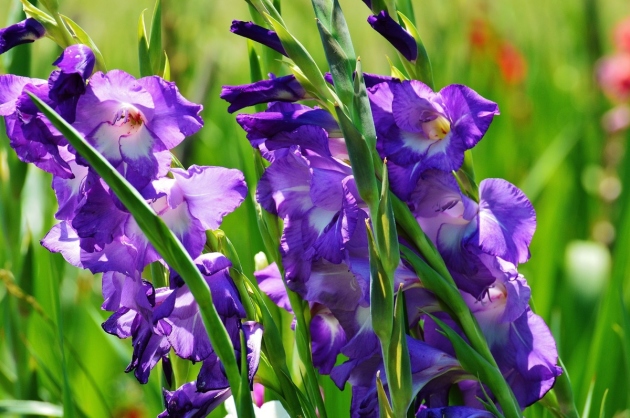
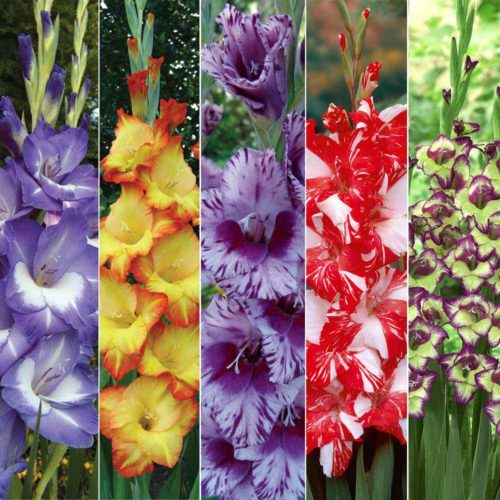
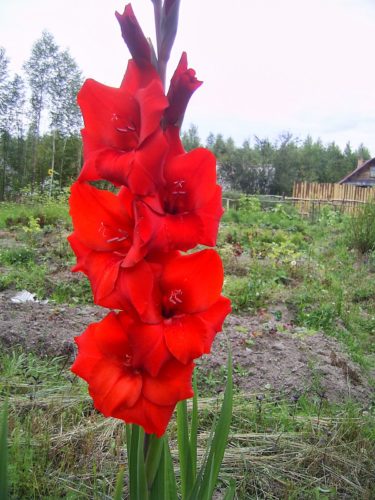
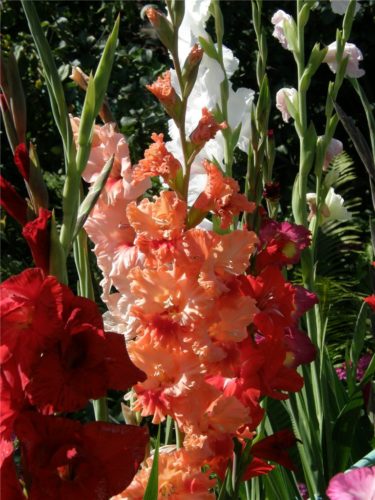

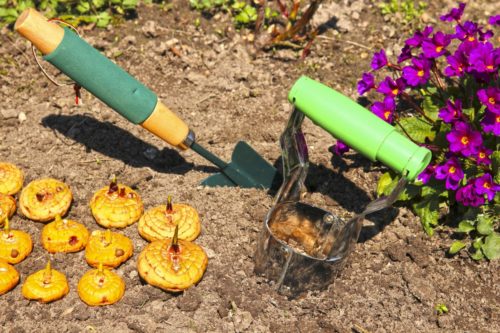













 Start a discussion ...
Start a discussion ...